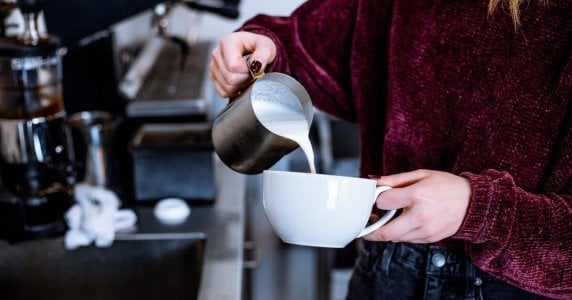Is full cream milk making a comeback? See why consumers are ditching low-fat varieties!
- Replies 6
Only a few years ago, low-fat milk seemed to be all the rage when it came to swapping foods for ‘healthier’ alternatives.
But now, it looks like the attitude towards milk is changing – with consumers moving away from the low-fat milk of the last decade in favour of the full-cream dairy variety.
According to data from Dairy Australia, more and more Aussies are reaching for full-cream milk.
The data compiled from supermarket sales revealed that full-cream milk sales increased 10 per cent over the past decade – reportedly higher than both low-fat and skim milk dairy sales.
Additionally, it was reported that full-cream milk comprised 60 per cent of all dairy milk sales between 2011 and 2012. The figures then jumped to 71 per cent through the years of 2021 to 2022.
But why is there an uptick in full-cream milk sales?
Glenys Zucco, Dairy Australia’s Marketing Strategy Manager and Dietitian explained that the figures reflected the ‘changing perceptions about what was healthy’. This is because there are more research findings that not all saturated fats are bad.
‘What is driving that is a realisation that full-fat dairy milk is not bad for you,’ Ms Zucco stated.
She continued: ‘A decade ago, full-fat dairy was associated with cholesterol and heart disease.’
However, she added that now we know regular fat dairy products ‘don’t have the same negative effect on heart disease risk’ compared to the saturated fats found in fatty meats, pastries, or packaged sweets.
Vice President of Dietitians Australia Jemma O’Hanlon claimed that whatever the type of dairy milk consumers drink, their weight and heart health are not impacted.
Ms O’Hanlon added that the benefits of milk (in general) had been known ‘for years’ before pointing out that milk has high levels of calcium and nutrients.
Data also backed up the change in consumer habits.
Australian per capita consumption of milk stood at 93 litres per person between the years 2021 and 2022. This amounted to over 250 millilitres per day.
Milk sales increased during the pandemic, but mostly in UHT or long-life milk (which is scientifically treated to have an extended shelf life) sales, according to Dairy Australia.
However, despite the jump in demand, fresh drinking milk was still the most popular choice for customers across the country.
Flavoured dairy milk also saw a steady rise in sales in the past few years. South Australia is leading in numbers, as people reportedly drink two to three times the national average.
Shop owner Paul Neindorf said he was not surprised by this change.
‘Not with the amount we go through. We are only a small store, but we go through a fair bit of flavoured milk,’ he shared with reporters.
‘Some of them have one or two a day, but I've known people who have four or five,’ he claimed.
He added that his customers come in and buy flavoured milk, such as iced coffee and strawberry, and chocolate, regularly.
Other dairy products, such as butter, saw a drop in overall sales. However, it was revealed that sales increased a little during lockdown.
Ms Zucco commented on this jump: ‘Consumers took up home cooking with gusto during the pandemic. I don't know about you. I was making scones and banana bread left, right, and centre.’
Cheese consumption has grown over the past year – from 13.4 kilograms to 15 kilograms per capita.
Of the cheese varieties, Cheddar was found to be the most popular choice for consumers, but other types, such as mozzarella and special cheeses, saw an increase in sales as well.
Dairy analyst Jo Bills said she saw traditional dairy staples from the 70s and 80s make a comeback in recent years.
‘We've had those conversations about whether the fat is as bad for you as we used to think, and people are really coming back to some of these traditional staple products for the taste and for the way they perform in their cooking,’ Ms Bills said.
This comes after data revealed that the dairy aisles of supermarkets are rapidly expanding, with claims that new types of milk are being introduced every couple of years. However, according to the data, 57 per cent of people admitted that full-cream milk was still their number one choice. You can read the rest of the report here.
 What sort of milk do you buy? Do you embrace full cream, low-fat or skim? Tell us your thoughts in the comments below!
What sort of milk do you buy? Do you embrace full cream, low-fat or skim? Tell us your thoughts in the comments below!
But now, it looks like the attitude towards milk is changing – with consumers moving away from the low-fat milk of the last decade in favour of the full-cream dairy variety.
According to data from Dairy Australia, more and more Aussies are reaching for full-cream milk.
The data compiled from supermarket sales revealed that full-cream milk sales increased 10 per cent over the past decade – reportedly higher than both low-fat and skim milk dairy sales.
Additionally, it was reported that full-cream milk comprised 60 per cent of all dairy milk sales between 2011 and 2012. The figures then jumped to 71 per cent through the years of 2021 to 2022.
But why is there an uptick in full-cream milk sales?
Glenys Zucco, Dairy Australia’s Marketing Strategy Manager and Dietitian explained that the figures reflected the ‘changing perceptions about what was healthy’. This is because there are more research findings that not all saturated fats are bad.
‘What is driving that is a realisation that full-fat dairy milk is not bad for you,’ Ms Zucco stated.
She continued: ‘A decade ago, full-fat dairy was associated with cholesterol and heart disease.’
However, she added that now we know regular fat dairy products ‘don’t have the same negative effect on heart disease risk’ compared to the saturated fats found in fatty meats, pastries, or packaged sweets.
Vice President of Dietitians Australia Jemma O’Hanlon claimed that whatever the type of dairy milk consumers drink, their weight and heart health are not impacted.
Ms O’Hanlon added that the benefits of milk (in general) had been known ‘for years’ before pointing out that milk has high levels of calcium and nutrients.
Data also backed up the change in consumer habits.
Australian per capita consumption of milk stood at 93 litres per person between the years 2021 and 2022. This amounted to over 250 millilitres per day.
Milk sales increased during the pandemic, but mostly in UHT or long-life milk (which is scientifically treated to have an extended shelf life) sales, according to Dairy Australia.
However, despite the jump in demand, fresh drinking milk was still the most popular choice for customers across the country.
Flavoured dairy milk also saw a steady rise in sales in the past few years. South Australia is leading in numbers, as people reportedly drink two to three times the national average.
Shop owner Paul Neindorf said he was not surprised by this change.
‘Not with the amount we go through. We are only a small store, but we go through a fair bit of flavoured milk,’ he shared with reporters.
‘Some of them have one or two a day, but I've known people who have four or five,’ he claimed.
He added that his customers come in and buy flavoured milk, such as iced coffee and strawberry, and chocolate, regularly.
Other dairy products, such as butter, saw a drop in overall sales. However, it was revealed that sales increased a little during lockdown.
Ms Zucco commented on this jump: ‘Consumers took up home cooking with gusto during the pandemic. I don't know about you. I was making scones and banana bread left, right, and centre.’
Cheese consumption has grown over the past year – from 13.4 kilograms to 15 kilograms per capita.
Of the cheese varieties, Cheddar was found to be the most popular choice for consumers, but other types, such as mozzarella and special cheeses, saw an increase in sales as well.
Dairy analyst Jo Bills said she saw traditional dairy staples from the 70s and 80s make a comeback in recent years.
‘We've had those conversations about whether the fat is as bad for you as we used to think, and people are really coming back to some of these traditional staple products for the taste and for the way they perform in their cooking,’ Ms Bills said.
This comes after data revealed that the dairy aisles of supermarkets are rapidly expanding, with claims that new types of milk are being introduced every couple of years. However, according to the data, 57 per cent of people admitted that full-cream milk was still their number one choice. You can read the rest of the report here.
Key Takeaways
- More Australians are ditching low-fat or skim milk for full cream milk, according to Dairy Australia.
- Full cream milk sales jumped 10 per cent in 10 years, taking a greater share of dairy milk drinking from its low-fat or skim counterparts.
- Dairy Australia's Marketing Strategy Manager and Dietitian Glenys Zucco said the figures reflected changing perceptions about what was healthy.
- Sales of flavoured dairy milk are also steadily rising, with South Australia leading the charge by drinking two to three times the national average.









